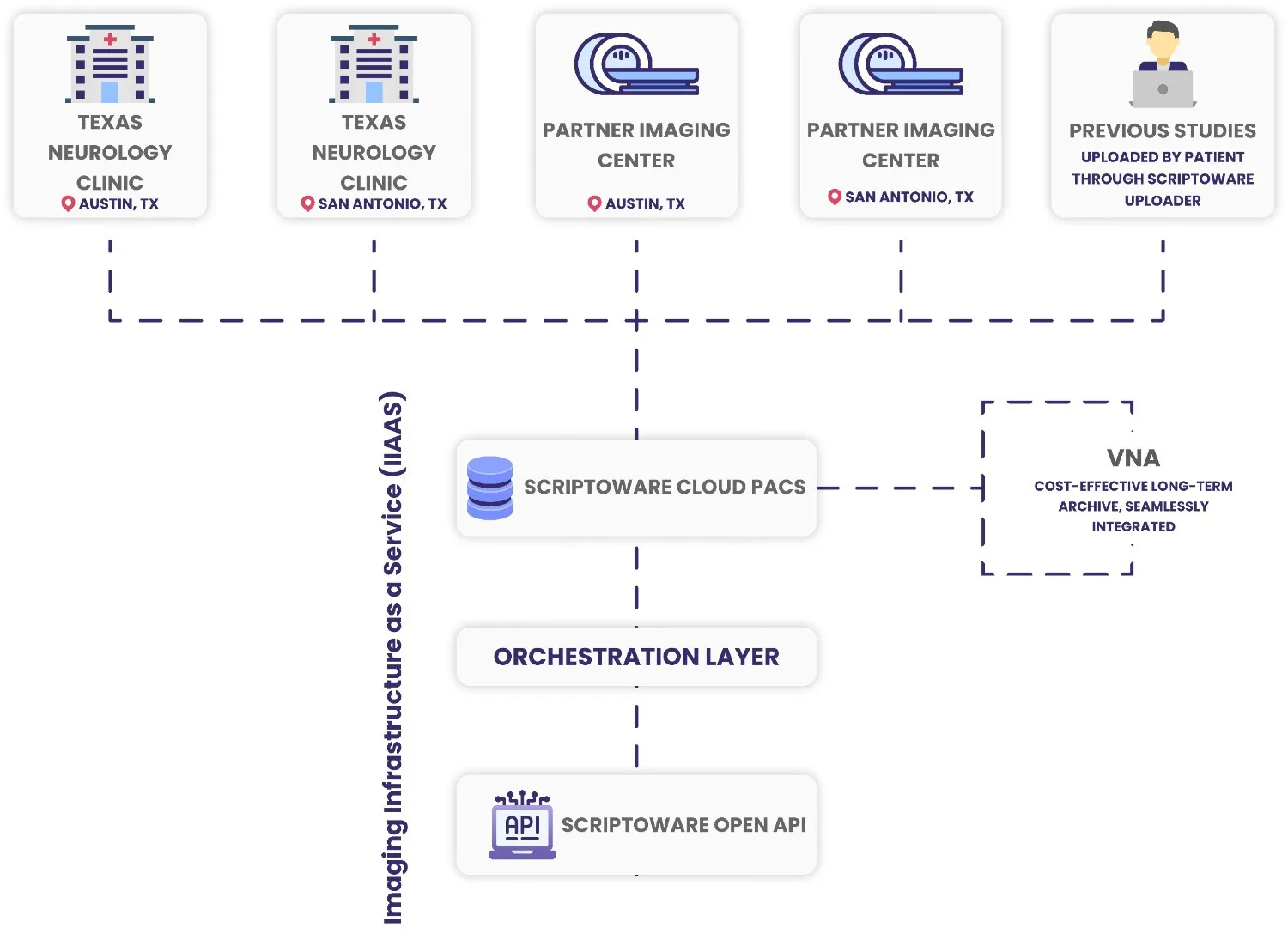
Vendor Agnostic Archive Gain Full Freedom and Break Vendor Boundaries!
Scriptoware’s Vendor Agnostic Archive offers healthcare providers the freedom to manage and access imaging data across any system. It removes vendor restrictions enabling smooth integration and long term scalability. The solution supports secure data control while ensuring compliance and flexibility. This helps healthcare teams reduce dependency costs and stay future ready.

What is a Vendor Agnostic Archive?
Scriptoware’s Vendor Agnostic Archive is a standards based, interoperable solution designed to securely handle the storage, retrieval, and sharing of medical images along with associated patient information. Unlike traditional PACS that are often tied to proprietary systems, this archive functions independently, integrating easily with diverse healthcare platforms and tools.
The platform accommodates a broad spectrum of imaging file types and complies with DICOM standards, ensuring seamless compatibility with various equipment from multiple manufacturers.
By enabling smooth access and transfer of images across departments and facilities, the Vendor Agnostic Archive enhances care coordination, improves clinical outcomes, and reduces operational complexity and expenses.

Key Features of Scriptoware’s Vendor Agnostic Archive
Unified Storage Solution
Scriptoware’s Vendor Agnostic Archive brings all scans together in one centralized space regardless of source or device. Radiologists can access everything from one location making workflows faster and more efficient.
Advanced Search Capabilities
Users can locate specific images using filters like patient name ID or anatomical region without needing to remember exact scan dates or exam details.
All Format Image Viewer
No need to juggle multiple tools. The built in viewer supports all standard formats offering a consistent and smooth viewing experience.
Seamless Image Sharing
Share images securely for cross team collaboration or remote consults. The platform enables protected file exchange that supports quicker coordination and second opinions.
Benefits of Using the Vendor Agnostic Archive to Revolutionizing Medical Image Management
Focused on putting patients first, our Vendor Agnostic Archive equips healthcare professionals with powerful tools to easily access, manage, and share imaging data. This promotes a collaborative, efficient, and patient centered approach to healthcare.
Unlimited Expansion Through Cloud Technology
Powered by Microsoft Azure, our archive offers expansive cloud based storage, allowing healthcare organizations to handle an ever growing volume of medical images without concerns over capacity limits.
Effortless and Flexible Image Sharing
The system supports smooth exchange of images among providers, patients, and referring physicians, compatible with popular formats such as DICOM, HL7, and secure web access ensuring flawless interoperability across diverse platforms.
Putting Patients in Control
The Vendor Agnostic Archive empowers patients by giving them easy access to their imaging records, encouraging proactive engagement in their care journey. It also helps cut down on duplicate imaging, saving time and reducing costs.
Enhancing Care Through Instant Access
Clinicians can quickly retrieve complete imaging histories, enabling faster diagnoses and more precise treatment decisions, ultimately improving patient outcomes and quality of care.
Capturing Medical Images
Scriptoware connects with various imaging machines and collects visuals into a central system. It also supports older PACS setups, making image transfer and access smooth across departments.
Format Standardization
Images are converted into the DICOM format for consistency. This ensures easy integration, system compatibility, and reliable access across platforms.
Data Archival
Storage is flexible and designed to scale with growing data. All files are securely stored and instantly retrievable, no matter how old or large.
Smart Organization and Tagging
Each image is labeled with key patient details for quick search and access. This reduces time spent on manual sorting and supports faster workflows.
Remote Access and Viewing
Authorized users can view images from any location. This improves clinical decision making and ensures imaging is always accessible when needed.
Easy Distribution
Built in tools allow secure sharing of images with colleagues, patients, or partners. This supports collaboration and coordinated care while maintaining privacy.
In Conclusion
Scriptoware’s VAA offers a scalable, compatible, and efficient platform for managing medical imaging and records. It improves access, reduces admin burden, and supports better care delivery.

Upload & Connect
Scriptoware’s advanced platform allows healthcare providers to smoothly collect medical imaging files from internal systems and devices while establishing easy connections with outside imaging partners. Patients can also upload their past scans or medical files so doctors can review them efficiently.
Secure & Organize
Scriptoware’s cloud based imaging system is designed to scale flexibly as your practice grows. All imaging data, including related reports, photos, and videos, is stored with strong security measures, fully aligned with HIPAA and GDPR requirements to protect patient privacy.
Our platform operates as a vendor Agnostic archive stored in the cloud, using a mix of storage solutions to ensure both performance and cost effectiveness.
We take care of backup processes and recovery strategies for the cloud environment and also provide tools that support local imaging setups such as on premises PACS systems.
Reasons to Choose Scriptoware’s Vendor Agnostic Archive (VAA)
Scriptoware’s Vendor Agnostic Archive offers a modern and reliable platform designed to simplify the management of medical imaging. Tailored for healthcare professionals, it ensures secure and convenient storing, retrieving, and sharing of medical images. By optimizing image handling, it supports healthcare providers in delivering improved patient care and operational efficiency.
Frequently Asked Questions
Adopting Scriptoware’s Vendor Agnostic Archive allows healthcare organizations to unify imaging data from varied sources into one consolidated system. This approach eliminates vendor restrictions, promoting seamless interaction among different healthcare technologies. Accessing medical images becomes easier, and exchanging data between providers is streamlined. VAAs are flexible and scalable, helping institutions adapt to rising imaging requirements without needing major infrastructure changes. Additionally, VAAs reduce the load on individual PACS storage, improving system efficiency and lowering costs. This vendor Agnostic setup empowers medical teams to better utilize imaging information, enhancing patient diagnosis and treatment.
A quality cloud PACS must handle multiple image formats to support a range of medical specialties like radiology, breast imaging, and digital pathology. It should feature robust security measures to safeguard patient information and meet compliance standards. The system needs efficient storage and fast retrieval capabilities, with scalable architecture to grow with increasing imaging volumes. Integration with hospital systems such as Electronic Health Records (EHR) and Radiology Information Systems (RIS) is essential for smooth clinical operations. User friendly interfaces are crucial, allowing medical personnel to easily browse and interpret images to ensure timely, accurate clinical decisions. Overall, a top cloud PACS combines versatility, security, and simplicity to enhance healthcare delivery.
While Scriptoware’s Vendor Agnostic Archive brings many benefits like data consolidation and improved interoperability, it is not intended to replace PACS. PACS systems remain vital for specialized departments including radiology and cardiology, providing essential tools tailored to their needs. They are key for managing diagnostic processes and delivering fast access to images. VAAs complement PACS by aggregating imaging data from multiple origins such as pathology systems and EHRs, offering a more complete patient view. The integration of cloud PACS and VAAs creates a powerful combination, enhancing data management and patient care outcomes.
Although Vendor Agnostic Archives bring workflow improvements and better data sharing, they also pose certain difficulties. Implementing a VAA can be complex and costly, requiring substantial resources, time, and expertise. Organizational resistance to change and staffing limitations may delay deployment. Despite offering cloud based hosting, concerns about data security and privacy must be carefully addressed to comply with regulations. Still, when implemented with strategic planning, the operational benefits usually surpass these obstacles, improving diagnostic efficiency and interoperability.
Scriptoware’s Vendor Agnostic Archive offers more flexibility, broader interoperability, and enhanced control over imaging data compared to traditional PACS. While PACS functions well within specific departments, VAAs serve enterprise level needs such as unified image management, long term storage, and avoiding vendor lock in. VAAs convert all images into standardized formats, facilitating access across multiple departments and facilities regardless of the original technology. Utilizing the DICOM standard, VAAs remove vendor barriers and enable seamless sharing of patient data across healthcare networks.
A Vendor Agnostic Archive system acts as a centralized, format independent repository for medical images and their related patient details. Unlike proprietary PACS solutions that often limit compatibility, VAAs promote effortless sharing of imaging data across various healthcare systems. Integrating a VAA consolidates fragmented data sources into a single platform, enhancing workflow efficiency. This unified access allows clinicians to make more precise diagnoses, better treatment plans, and ultimately deliver improved patient care.
Future proof your medical imaging management and workflows
Effortlessly access, view, store, and share medical imaging data with a robust, multi location cloud PACS system, zero footprint DICOM viewers, AI capabilities, and top tier sharing features.

